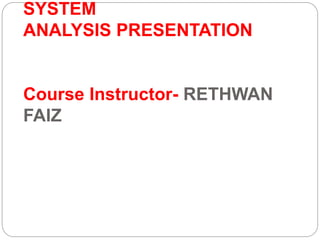Psa final
- 1. SYSTEM ANALYSIS PRESENTATION Course Instructor- RETHWAN FAIZ
- 2. NAME ID 1. Alam iftekhar ul 12-22225-3 2. Hasan,Md.Nazmul Anas Bin 13-24437-2 3. Shiblu Nazmul Huda 12-22183-3 4.Rahman,MD.Sadiqur 13-24415-2 5.Delowar,Chowdhury Salahuddin 13-23737-1
- 4. Aim of our presentation is to just give you a brief idea about the smart card technology being one of the best steps towards the advancement of science and technology , making our life faster and obviously easier.
- 5. CONTENTS. ? What is smart card? ? The dimensions. ? Types. ? What is ISO 7816,and ISO 14443. ? Why use smart card ? ? Uses of smart card. ? Advantages. ? Disadvantages. ? Use of smart Card. ? Future. ? Conclusion.
- 6. 1. What is a smart card? ? The standard definition of a a smart card, or integrated circuit card (ICC), is any pocket sized card with embedded integrated circuits. OR ? A smart card is a plastic card with a small, built in microcomputer chip and integrated circuit that can store and process a lot of data
- 7. Dimensions of smart card. 85.6mm x 53.98mm x 0.76mm(defined by ISO 7816
- 9. ? Vcc - gives the biasing voltage to the smart card. ? RST- resets the data stored in the smart card. ? CLK- provides the clock signals for the operations. ? GND ®C provides ground as usual. ? Vpp ®Cprovides the programming voltage to the EEPROM.But now it is not used,because the modern cards are capable of generating programmin voltage by itself when comes in contact with a reader. ? I/P,O/P- is the input output port. ? AUX1/2- are auxilliary contacts,used by USB
- 10. Types of smart card. ? Contact smart cards. ? Contactless smart cards. ? Dual interface smart cards. ? Hybrid smart cards. ? Integrated circuit microprocessor smart card.
- 11. 1. Contact smart card. ? Contact smart cards have a contact area comprised of several gold plated contact pads(chip) ? A contact smart card must be inserted in to a smart card reader with a direct connection to the conductive plates of the surface of the smart card.
- 12. 2. Contactless smart card. ? Uses an inbuilt internal antenna for communication with the card reader. ? It just requires a close proximity (10 cm.)to the reader.The readers also have an inbuilt internal antenna to identify the smart card and communicate with it. ? The antenna used in these use radio frequency to communicate.
- 14. 3.Dual interface smart cards. ? Also called Combi card. ? Has a single chip over it. ? Has both contact as well as contactless interfaces. ? We can use the same chip using either contact or contactless interface with a
- 15. Dual interface smart card.
- 16. 4.Hybrid smart card. ? Two chips. ? One with contact interface. ? Other with contactless interface. ? No connection between the two chips.
- 18. 5.Integrated circuit (ic) microprocessor card. ? Microprocessor cards , also called as chip cards offer greater range of memory storage of data than a traditional smart card. ? Chips used are also called as microprocessors with internal memory.
- 19. What is iso 7816, iso 14443 . ? 1. ISO-7810. ? Internationally accepted standard for smart cards. ? Deals with different aspects of smart card. Like:- a. Dimensions. b. Radio frequency range. c. Mechanical stress. d. Location of IC in the card. e. Location of magnetic strip in the card. Etc°≠
- 20. ISO-7816. ? Has 14 divisions. ? Part 1,2,3- deal with contact smart card.(defines its physical aspects). ? Part 4,5°≠..9;11,12°≠..15- deal with both contact as well as contactless cards. Define- a. Card logical structure. b. Programming. c. Biometric verification. ? Part 10 defines the chip for memory cards for applications like telephone or electricity billing.
- 21. ISO 14443. ? International standard. ? Deals ®C only contactless smart cards. ? Defines:- a. Interface. b. Radio frequency interface. c. Electrical interface. d. Operating distance. Etc°≠..
- 22. How it works
- 23. Uses:- ? Net surfing. ? Electronic purse(debit/credit card). ? Banking(ATM card). ? Employee attendance. ? Medical identification. ? Identity card. ? Driving licence. ? Pan card. ? Passport. ? Payphones. And many more apps..
- 24. Advantages:- ? Faster and smarter. ? Portability. ? Flexibility(no need to carry separate ATM,Debit,Credit card or DL,pan card etc.). ? Highly secured.(deactivates on illegle use). ? Gives its own network for internet suefing. ? Reliability (unaffected by electric and
- 25. Disadvantages:- COST AND AVAILABILITY ? Expensive. ? All readers can not read all types of smart card(depends upon the smart card brand).
- 26. Why Smart Cards ? Improve the convenience and security of any transaction. ? Provide tamper-proof storage of user and account identity. ? Provide vital components of system security. ? Protect against a full range of security threats
- 27. Future ? Health Services ? Education ? Transportation ? Tele-communications
- 28. Conclusio n.
- 30. Thank You
Editor's Notes
- #5: Aim of my ppt is to just give you a brief idea about the smart card technology being one of the best steps towards the advancement of science and technology,making our life faster and obviously easier.






























